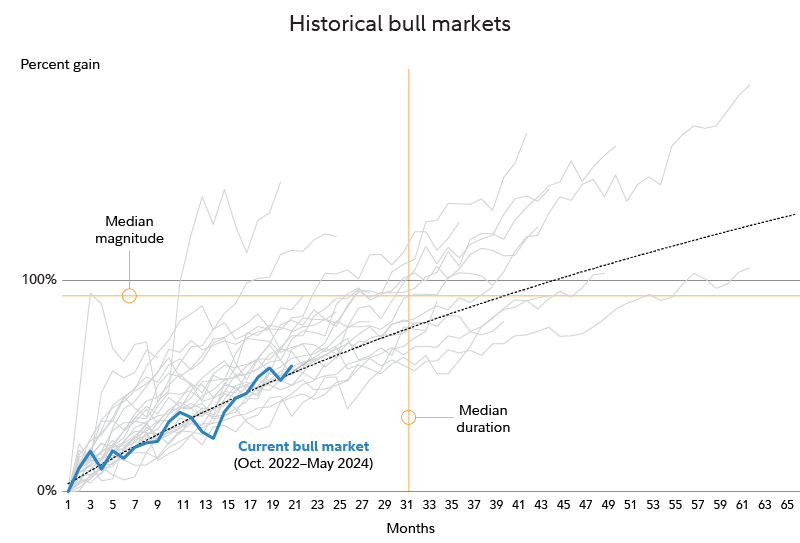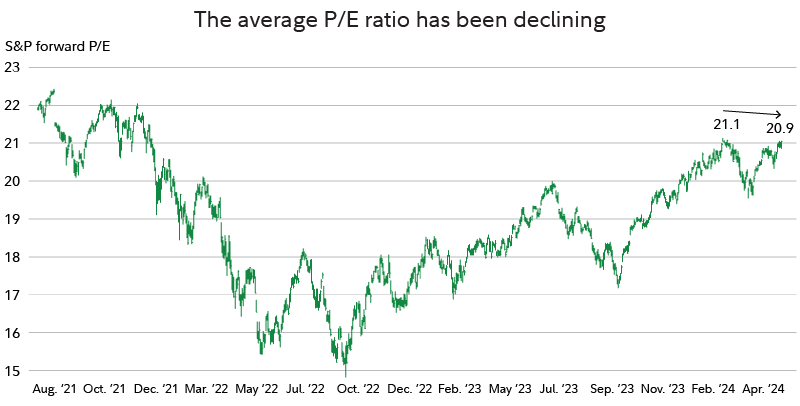It's been a strong year for stock investors so far, with the S&P 500 up by more than 10% year-to-date and many of the major indexes notching record high after record high.
Yet rather than stoking greed, these gains seem to be sparking fears for many investors—that gains might be overdone, that the market might be near a top, and that the bull might be on its last leg.
As we come up on the halfway mark for the year, here's a look at my latest thinking on where this bull market stands, what might be in store for stocks over the second half of the year, and what I’m seeing on the longer-term horizon.
Bull market in its seventh inning?
I believe that the bull market that began in October 2022 is aging, but still has room to run.
To put it into perspective, the current bull market is now 20 months old and has produced a gain of more than 50% (from the S&P's October 2022 low to its most recent high). Contrast that with the median historical bull market, which has lasted 30 months and produced gains of around 90%—looking at the past 100 years or so of market history.

Looking just at those numbers, we might only be in the fifth inning of this bull market.
However, I think that some of the dynamics to this cycle—namely high inflation and interest rates, which generally put pressure on stock valuations like price-earnings (P/E) ratios—make it less comparable to some historical bull markets. Focus specifically on periods when there were similar pressures (particularly in the 1960s and 1980s), and historical bull markets have often been shorter and shallower—with typical gains closer to 65% to 75%.
Hence my belief that we are further along in this cycle—perhaps in the seventh inning. While that might sound pessimistic to some investors (sure, 7 is closer to 9 than to 1), I do think time is still on our side here.
Election-year patterns
Another key factor this year is that we’re in year 4 of the presidential-election cycle, and that year has historically tended to be strong—particularly when it follows a down mid-term year (which we saw this cycle).

So far, we've been tracking this fourth-year pattern very closely. If we continue to do so, that might suggest that the bull market could continue for the remainder of this year.
Rising earnings providing support
As I said above, higher rates and inflation tend to pressure valuations like P/E ratios. Rising markets must be fueled by either rising valuations, rising earnings, or both. Much of the ground this bull market has covered so far has been driven by rising valuations. Fortunately, it looks like the baton is being passed from the valuation-led phase to the earnings-led phase. Consensus earnings estimates have risen to 12% estimated growth for the next 12 months, and 17% estimated growth for the next 18 months.
This earnings momentum is allowing the market's P/E ratio to come down somewhat. In the next chart, we see that the forward P/E ratio (meaning, the P/E based on estimated earnings for the next 12 months) has been hitting lower highs—even as the S&P 500 has been making higher highs.

Meanwhile, earnings estimates for both 2024 and 2025 have been rising. That's unusual, since these estimates usually start too high and then drift lower. So we are seeing some clear signals of earnings acceleration.
What's driving that earnings momentum? Rising profit margins, by the looks of it. The operating margin for the MSCI USA index has now improved to 13.0%, which is just shy of its most recent peak in 2021.
What of the Fed?
Of course, key to the market's performance over the rest of the year may be Fed policy, and whether investors finally get those rate cuts they have been hoping for this year.
There was a disconnect toward the start of the year between investors' hopes for big rate cuts and the Fed's projections of smaller rate cuts. That disconnect has largely been corrected now, with investors moderating their expectations after some surprisingly hot inflation readings earlier in the year.
But I believe it's fair to say at this point that the Fed has an easing bias (as opposed to a hiking bias), given that there are signs of growth moderating and given that inflation has fallen to the 3% to 4% range. It may just be a question of how many rate cuts and when. The forward curve has been pricing in the first rate cut before the end of year, which makes sense in my opinion.
Bottom line for the current bull market: For now, growing earnings and a moderating Fed appear to have the upper hand over high valuations and sticky inflation. Seventh inning.
The longer-term view
So far, we've been talking about the bull market that started in October 2022—which I’d also call a "cyclical" bull market. But I also look at what I'd call longer-term "secular trends," or super cycles.
I believe that since the 2008–2009 financial crisis, US stocks have been in a super cycle of above-average returns. Those above-average returns have been driven by several factors, including falling interest rates over much of that period, rising margins, and buybacks and M&A (merger and acquisition) activity that has reduced the supply of shares. Buybacks, in particular, have been a powerful driver of higher P/Es. On a cumulative basis since 2009, the issuance of shares has totaled about $2.7 trillion, while the reduction in shares has totaled about $21.3 trillion. That's a huge supply-demand imbalance against a US market cap of about $44 trillion.
Of course, returns can only be above average for so long before mean reversion kicks in. Estimating when this might happen is complex. But based on my modeling, I believe we are also in the seventh inning of this secular bull market.
The current super cycle has tracked previous bull-market super cycles of 1949 to 1968 and 1982 to 2000 quite closely. In terms of the total price gain or total length of the super cycles, we seem to still have room to run. But I think it's important to also look at valuations. My favorite valuation metric is the 5-year price-to-total-cash ratio (with total cash including dividends and share buybacks). Comparing the current period to past super-cycle regimes, on a price-to-total-cash basis the current secular bull does not appear to be over its skis yet.
Having said that, it's fair to note that valuations are historically high. While valuations are useless in predicting short-term returns, they have historically been effective in predicting long-term returns. This is evident through a clear inverse correlation historically between the trailing 5-year price-to-total-cash ratio and the market's subsequent 10-year compound annual growth rate.
To turn that historical relationship into a projection (and to try to get a sense of when this secular bull market might peter out), I created a regression model, using the 5-year price-to-total-cash ratio as an input and generating estimated subsequent 10-year compound annual growth rates as an output.

If this model is correct then, based on the lower panel of the chart, the current bull super cycle could reach a peak around 2026. Hence, my call that we might be in the seventh inning.
It's important to note that a peak of the secular bull in 2026 would not be the end of the world and would not necessarily imply a market peak, or that the market would go down after that. Rather, it would mean that the 10-year average return might shift from above-average (i.e., above 11%) to below-average (i.e., below 11%). Below average can still be a rising market.
Of course, past performance is never a guarantee of future results, and all this assumes that the market follows a rational valuation roadmap, which is not always the case. Therefore, I would not set my watch too closely to this roadmap, but instead use it as a rough guide for strategic investment allocations.




